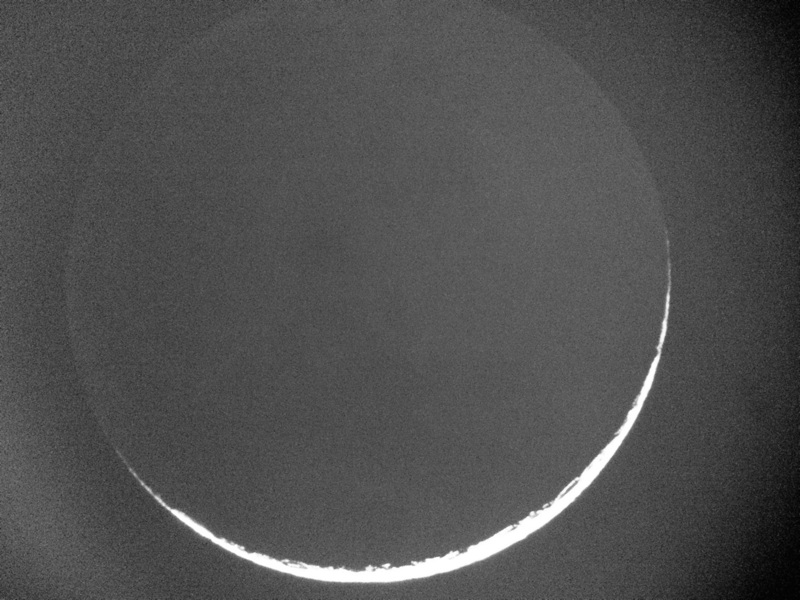
Meade Diagonal Update; Crescent Moon, M1 Crab Nebula
Posted: 1 April 2014
|
Opened: Monday, 1 April 2014, 1849 MST Temperature: 74°F |
Session: 667 Conditions: Clear, some breezes |
Received the replacement eyepiece holder screw for my Meade 2" 99% Reflectivity Diagonal on Thursday, 27 March. The original screw had been bent in shipment. New screw worked perfectly. Thanks Meade!
1900 MST: viewed a thin crescent moon, 83X. Moon was about 33.3 hours old and 4.7% illuminated. Did some iPhone 5s afocal 83X handheld photos and D7000 DSLR photos:
iPhone afocal, 1903 MST:

D7000, f/5, 1/20sec, ISO 400, 52mm, 1913 MST:

iPhone afocal, 1922 MST, showing Earthshine:

D7000, f/5.6, 1/20sec, ISO 1600, 105mm, 1928 MST:

1931 MST: viewed Jupiter, 83X. Four moons were visible. At 222X, the Great Red Spot was visible approaching the central meridian. Began setting up for iPhone afocal video recording of Jupiter. Tried 444X but seeing not good enough. However, the view looked good at 267X so I decided to use that magnification. Added one of the filters from the 2" Variable Polarizing Filter to the 2" 2X PowerMate and checked the exposure with the iPhone Camera app. It seemed to be overexposed, so removed the filter and added a 1.25" moon filter. Better exposure. This is a stack of 1701 frames from a slo-mo (120fps) video, afocal 267X + moon filter using my homemade afocal adapter, upscaled 200%:

2000 MST: the Zodiacal Light was very distinct this night.
2006 MST: viewed M1 (Crab Nebula), 83X. Began preparing the D7000 DSLR for 8" prime focus imaging. After doing a focus test image on the star Aldebaran using the Bahtinov Mask, I did 10 manually guided 2 minute, ISO 6400, exposures of M1. This is a stack of the 9 images, effective exposure length 18 minutes, desaturated:

During post-processing I discovered that a "space worm" had been photographed in all the M1 2 minute exposures. It first appeared to the right of the Crab (first photo below), then proceeded to the left and down. The first photo is a full frame image (color) and the next two are cropped, desaturated, and highly edited to show the "worm".



The "space worm" only appeared on the M1 photographs and did not appear on photos before and after imaging M1. Of course, I suspect some debris (cat hair, etc.) actually caused it. I will clean the D7000 DSLR sensor using the DSLR Camera Sensor Cleaning Kit.
2100 MST: completed M1 imaging. Breezes were getting more frequent and stronger. Slewed to M49 (galaxy), but no good guide star located. Did a 2 minute, ISO 6400, unguided image but nothing was obvious on the photograph. Enabled High Precision on the LX200-ACF and tried again; still nothing obvious with a 2 minute exposure. Too breezy for more imaging; will try again on the next session. I imaged the M49 galaxy on 26 April 2012 using a 5 minute, ISO 6400, exposure, but I hope to improve on that image.
2141 MST: viewed M49, 83X. Slewed to Mars and viewed it at 83X and 222X. Seeing was not good but the North Polar Cap and hints of dark areas were visible using 222X. It was windy now so began closing up.
|
Closed: Monday, 1 April 2014, 2200 MST Temperature: 59°F |
|
My 23 March report mentioned that I had contacted Vello about the failed ShutterBoss wireless receiver. On Monday, 24 March, I heard back from them and a replacement receiver ($50) was shipped from B&H Photo on Monday, 31 March.
In case you missed the announcement, check out my report on observing with the WIYN 3.5 Meter Telescope at Kitt Peak.
The day after the Kitt Peak visit, the strongest wind gust ever at Cassiopeia Observatory was recorded:

There was no damage at the observatory.
In other news, I have begun working with Oracle State Park and the International Dark-Sky Association to pursue an "International Dark Sky Park" designation for the Park. We hope to complete the application process this summer. Once Oracle State Park has earned the IDSP designation, it will be the first park in the Arizona State Parks system so honored and will be the model for other parks in Arizona to pursue IDSP designation. I will provide updates here as we proceed on the path to the designation.
Comments are welcome using Email. If you are on Twitter you can use the button below to tweet this report to your followers. Thanks.
Cassiopeia Observatory Home Page